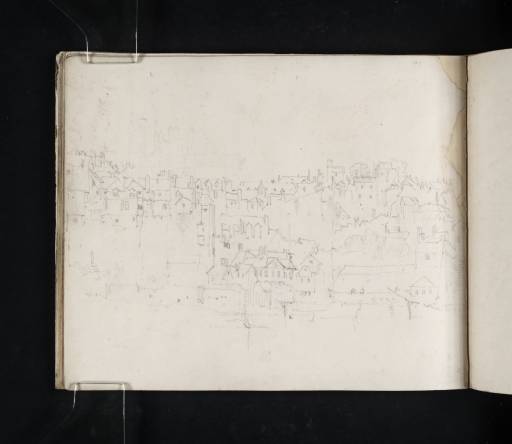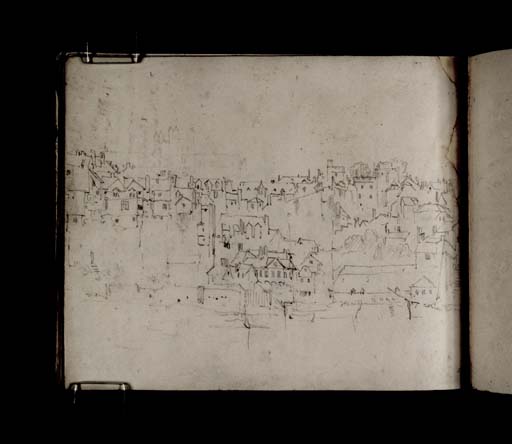Joseph Mallord William Turner Exeter: The Quay and Customs House below the Cathedral 1811
Image 1 of 2
Joseph Mallord William Turner,
Exeter: The Quay and Customs House below the Cathedral
1811
Joseph Mallord William Turner 1775–1851
Folio 31 Verso:
Exeter: The Quay and Customs House below the Cathedral 1811
D08844
Turner Bequest CXXIV 31
Turner Bequest CXXIV 31
Pencil on white wove paper, 170 x 209 mm
Blind-stamped with Turner Bequest monogram bottom centre
Stamped in black ‘CXXIV – 31’ bottom right on the recto (see discussion below)
Blind-stamped with Turner Bequest monogram bottom centre
Stamped in black ‘CXXIV – 31’ bottom right on the recto (see discussion below)
Accepted by the nation as part of the Turner Bequest 1856
References
1909
A.J. Finberg, A Complete Inventory of the Drawings of the Turner Bequest, London 1909, vol.I, p.354, CXXIV 31, as ‘Exeter, with Cathedral in distance’.
Turner shows Exeter’s pedimented 1681 Customs House1 on the River Exe in the centre of the foreground, with the Cathedral sketched in lightly on the skyline to the left, about half a mile north-north-east. To the left is part of the city wall, which climbs the hill towards the right (where a prominent block of flats now stands) to the castellated tower of Old Trinity Church. From the south bank at Haven Road the immediate view of the Customs House from this angle is now obscured by other riverfront buildings. Little of the medieval city that Turner recorded on the hillside survives intact owing to World War II bombing and redevelopment, but the general character of the working quay has been preserved.2
The watercolour Exeter of about 1827, made for Turner’s Picturesque Views in England and Wales (Manchester Art Gallery),3 shows the recent terrace of houses on Colleton Crescent, contrasted with and partially eclipsing the medieval cathedral to the north, looking across the Exe south-east of the Custom House quay. There is no identified drawing for the subject in the Turner Bequest, and it has been suggested that the watercolour was made from memory,4 but the precision with which the terrace is depicted appears to indicate otherwise. It would have been logical for Turner to travel a little further down the river to make a pencil sketch of that view to complement the two identified drawings of adjacent sections of the waterfront with the cathedral beyond in the present drawing and on folio 30 verso (D08842). For further views of Exeter, see the entry for the latter.
This page was recorded by Finberg as if it were a recto (without the ‘a’ suffix by which he usually indicates a verso), but the drawing he describes is bound as the verso of the sheet and stamped on the blank ‘recto’. When Tate accession numbers were allocated to the book the verso (i.e. the present drawing) was originally designated as D08845, but the number was cancelled as redundant.
Technical notes:
Large areas of loss at the top right and down the right-hand edge have been replaced. There is a small hole towards the top left. There is heavy brown spotting on the ‘recto’ of the sheet.
Matthew Imms
February 2011
How to cite
Matthew Imms, ‘Exeter: The Quay and Customs House below the Cathedral 1811 by Joseph Mallord William Turner’, catalogue entry, February 2011, in David Blayney Brown (ed.), J.M.W. Turner: Sketchbooks, Drawings and Watercolours, Tate Research Publication, December 2012, https://www


